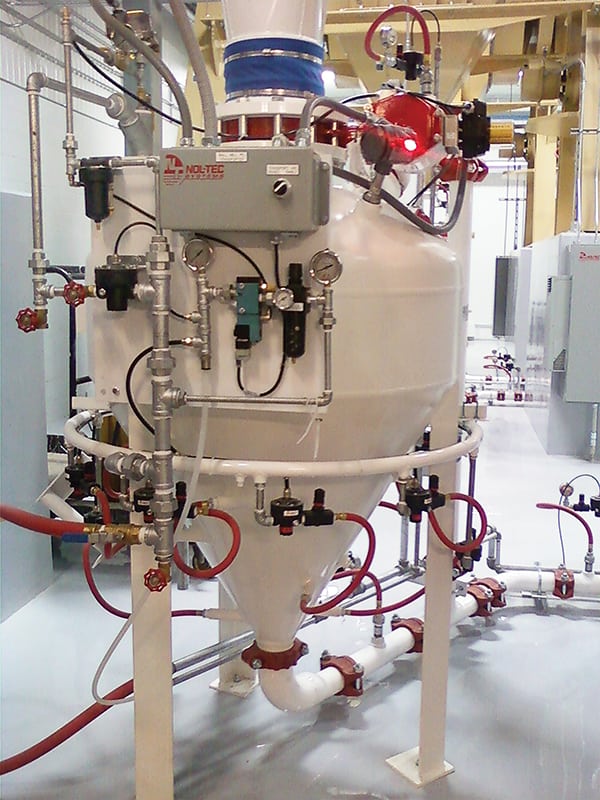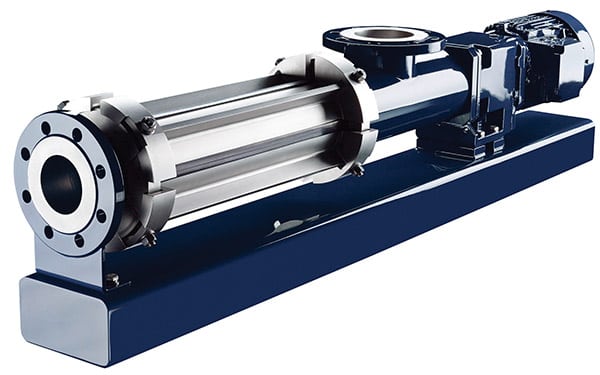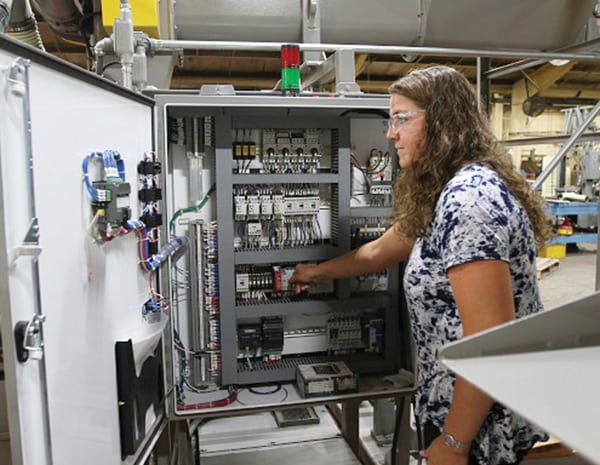Updated feeding and conveying products help improve product flow
When it comes to feeding and conveying operations, chemical processors struggle to minimize unplanned downtime and maximize throughput. For this reason, they require reliable equipment that is easy to clean in an effort to prevent cross contamination, feeders and conveyors that do not degrade or separate their product, and systems that eliminate material handling issues related to difficult-to-process materials. “Time is money and processors have labor costs, capital equipment depreciation and overhead costs. Losses from wasted ingredients, reagents, revenue and profit only make the issues more significant,” explains Gordon Fenton, engineering and product development manager with Seepex (Enon, Ohio; www.seepex.com). “And the stakes are so much higher for chemical processors, since many processes are batch-oriented. Batch processes have increased risks because of the potential for wasted batches when the component chemical costs can be so high.”
Selecting the best equipment design for a specific application and its challenges, as well as integrating new equipment with precise controls into existing facilities, can help chemical processors improve the flow of product through their facility, while keeping costs associated with downtime and decreased throughput to a minimum.
The biggest feeding and conveying challenges for chemical producers include degradation and separation of product, cross contamination, downtime and difficult-to-process materials, so manufacturers of this equipment are working closely with chemical processors to understand the specific needs of the industry and are developing units and systems designed to tackle the chemical process industries’ (CPI) greatest issues.
Reducing degradation/separation
“One of the biggest challenges of handling bulk material is maintaining product integrity from start to finish. The constant particle-to-particle and particle-to-surface contact during the conveying and material-handling processes breaks down the material quality. The goal is to mitigate these negative effects by reducing material turbulence within the conveyor,” notes Greg Patterson, vice president of Hapman (Kalamazoo, Mich.; www.hapman.com).
Segregation, according to Patterson, is another common issue. “There are a number of factors that influence whether your material segregates as it moves through the process. The size, shape, density and moisture content of the ingredients; the speed of transfer; whether it is conveyed mechanically or with air; the length and angle of the conveyor; even the presence of static electricity influences the stability of the blend,” he says.
One example of a conveyor designed to combat these issues is a tubular drag chain conveyor. “The design of this type of conveyor prevents product from being stirred or blown during movement, so there is no damage or separation as it moves along the process,” explains Patterson. “Often degradation and separation of product occur at conveyor transfer points, but with a tubular drag conveyor, you can replace multiple conveyors and multiple transfer points with one unit that can go horizontal, vertical, handle angles and go around corners. We can provide many configurations with one conveyor so there is no need for multiple transfer points, thus mitigating many of these challenges.”
Nol-Tec Systems (Lionel Lakes, Minn.; www.nol-tec.com) suggests dense-phase transporter systems to users who must avoid degradation in powder and granular bulk-solids moving through a pipeline at low velocity. In a typical cycle, the transport vessel fills via gravity. When the transporter is full, the inlet and vent valves close and the system is pressurized, allowing material to flow into the conveying line and on to the destination. “The low velocity minimizes degradation to materials that are fragile,” says Mike Weyandt, corporate sales manager with Nol-Tec. “Imagine moving a Rice Krispie at high velocity. At the end of the conveyor it wouldn’t be a Rice Krispie anymore. It would be powder.”
Though this type of technology is not new, Nol-Tec is adding features to further improve performance, says Weyandt. To overcome the overall resistance in the conveying line, Air Assists are placed strategically to distribute energy throughout the system (Figure 1). This results in increased efficiency and reliability. The Air Assist technology prevents back feeding, which may be experienced with low-pressure manifold systems. On longer systems, Air Mizer technology can be added to further reduce compressed air costs. This version of Air Assist technology introduces air only when required.

Figure 1. To overcome resistance in the conveying line, Nol-Tec Air Assits are placed strategically to distribute energy throughout the transport system. This results in increased efficiency and reliability Nol-Tec
Simplified cleaning
“Many processors don’t have systems that are dedicated to the same material 24/7/365. Instead, they may be a compounder who can’t have two colors mixed or running two incompatible materials, so cross-contamination is a major concern,” says Todd Messmer, applications engineering manager with Schenck Process (Whitewater, Wis.; www.schenckprocess.com). “Because cleanability and the time associated with cleaning are concerns we have to take into consideration, we’ve come up with a couple of systems that assist processors with cleaning conveying equipment, such as quick-disconnect piping, couplings that fit together and come apart without tools, as well as a pigging system.”
Messmer says the pigging system was designed to help processors with long conveying lines clean and avoid cross-contamination. “The device is shaped like a torpedo and is launched into the conveying line and, as it moves through, scrapes and cleans the inside of the conveying line and pushes the debris into a common collection point,” explains Messmer. “This pigging system is clearly a better, faster, more thorough way to clean pneumatic conveying lines without having to disassemble the whole thing.”
Another take on simplified cleaning is the addition of tubular trays to vibratory feeders, says Rob Yandrick, product manager, vibratory/screening, with Eriez (Erie, Pa.; www.eriez.com). Trays are designed for fast removal and cleanout to avoid cross contamination of materials and decreased production line downtime. Many trays offer quick-release clamps that allow the tray and cover to be removed without tools so that the tray is easily lifted and disconnected from the frame for easy cleaning. In addition to assisting processors with avoiding cross contamination, the tubular trays also help with general housekeeping and dust containment, says Yandrick.
Increasing reliability and uptime
“The most valuable advances in processing are improving mean time before failure, predictive maintenance and making installation and maintenance quicker, safer and cheaper,” says Seepex’s Fenton. “In the past, progressive-cavity pump manufacturers fell short on the serviceability aspect, but Seepex now offers a single- and two-stage Smart Conveying Technology (SCT) pump designs that allows the pump stator or rotor (or both) to be changed without disturbing suction or discharge piping (Figure 2). The design also does not require the rotor and stator to be removed as a cartridge and separated later. This change makes most maintenance operations a one-person operation, cuts maintenance time by up to 85% and decreases spare part costs, says the company.

Figure 2. Seepex now offers a single- (shown here) and two-stage Smart Conveying Technology (SCT) pump design that allows the pump stator and/or rotor to be changed without disturbing suction or discharge piping to increase reliability and decrease downtime
Seepex
The company’s Intelligent Metering Pump (IMP) is also helping to increase uptime. It offers an Electronic Programming Module (EPM) memory chip on which parameters can be pre-configured. This makes replacement of a drive simple, quick and accurate. Users can plug the EPM chip from the previous drive into the new one and be up and running.
It has also allowed many processors to convert from a batch to a continuous process and eliminate bottlenecks, says Fenton. “When combining chemicals, one of the main components is some sort of metering pump. Metering this type of application used to require a pump that pulsated and that pulsation required them to work in a batched process to get a homogeneous mixture,” he says. “However, the IMP does not have to pulsate. It offers a continuous flow, which allows some processors to convert to a continuous process, allowing them to increase their throughput.”
The flow of difficult materials
“One of the greatest obstacles to uptime in feeding and conveying applications is dealing with problematic materials, such as those that are sticky, or exhibit bridging or agglomeration, because they can reduce flow, which may result when materials don’t come out of the containers,” says David Boger, vice president, global business development, with Flexicon (Bethlehem, Pa.; www.flexicon.com). “But, the proper bulk bag discharge system can help rectify this issue and get product flowing.”
Flexicon’s Bulk-Out bulk bag dischargers (Figure 3) are available in several frame configurations, including the BFF Series dischargers with bag lifting frame for forklift loading and unloading of bulk bags and BFC Series dischargers with cantilevered I-beam, electric hoist and trolley for loading and unloading of bulk bags without the use of a forklift.
Figure 3. Flexicon’s Bulk-Out bulk bag dischargers are available with several accessories designed to increase efficiency and deal with difficult-to-handle materials, including the Spout-Lock clamp ring and Tele-Tube telescoping tube
Flexicon
The dischargers are offered with several accessories designed to increase efficiency and deal with difficult-to-handle materials, including the Spout-Lock clamp ring and Tele-Tube telescoping tube. The clamp ring creates a high-integrity, sealed connection between the clean side of the bag outlet spout and the clean side of the telescoping tube. This prevents contamination of the product, while eliminating the plant contamination that occurs when falling materials displace air and dust from the hopper.
The telescoping tube prevents dead spots and promotes flow by raising the Spout-Lock clamp ring for connection to the bag spout, then lowers, applying continual downward tension. As a result, the spout is kept taut at all times, preventing excess spout material from bulging outward (creating dead pockets) or falling inward (creating flow restrictions).
The company’s pneumatically activated Flow-Flexer bag activators promote material flow through bag spouts. The bag activators raise and lower the bottom edges of the bag to direct material into the bag outlet spout and to raise the bag into a steep “V” shape to promote total evacuation. Bulk bag conditioners are also available for loosening materials solidified in bulk bags.
Integration and smarter controls
To pull all these pieces of equipment and their benefits together, many equipment providers are also offering custom-engineered, integrated systems. Flexicon, for example, can evaluate bulk materials, plant layout, throughput rates, residual product limitations, cleanliness requirements, access, cost, cycle times and other parameters and outline a solution for the situation.
Along with this type of sophisticated system, processors are requesting more integrated and smarter controls. “Processors want to see more of what’s going on with their system and they often want to see it from a remote location,” says Nol-Tec’s Weyandt. “At the same time, they’re asking for more automated controls for functions that were previously manually adjusted.”
Hapman’s Patterson agrees: “The integrated solutions and the desire to have smarter control systems required an improvement in our control capabilities. We needed to be able to handle functions from scanning barcodes to keeping track of all the elements in a conveying system as product moves through the circuit, which mandated smarter control systems.”
As such, Hapman currently offers control packages that range from smaller panels with on/off and alarm notifications to fully integrated packages, which incorporate multiple pieces of equipment and link directly to a range of hardware options and HMI interfaces for customer-specified components and notification requirements (Figure 4). “Our customers want smart equipment that can tell them how it is performing and when performance isn’t quite where it needs to be,” he says. “So, we have to make sure our equipment and controls are providing the kind of feedback processors require so they can continue to keep their product and process flowing.”

Figure 4. Hapman provides control packages that range from smaller panels with on/off and alarm notifications to fully integrated packages, which incorporate multiple pieces of equipment and link directly to a range of hardware options and HMI interfaces for customer-specified components and notification requirements
Hapman